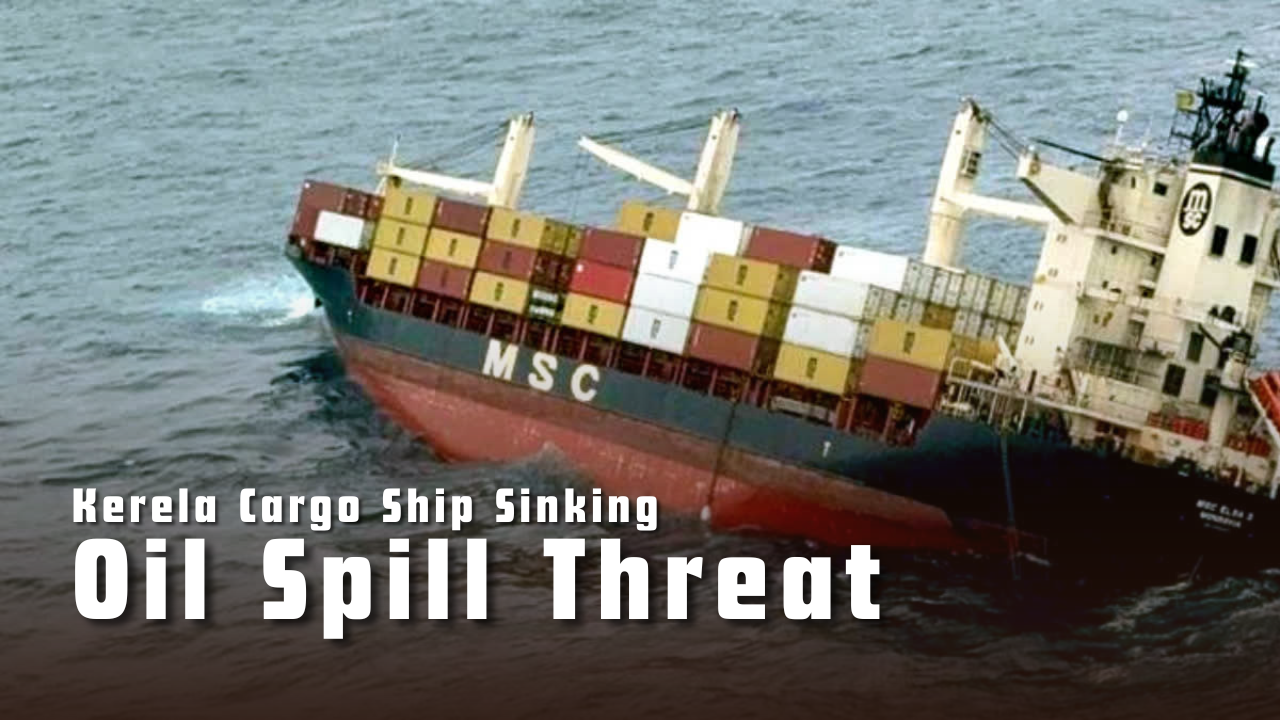Kerala Cargo Ship Sinking and Oil Spill Threat
Cargo ship sinks near Kerala coast: What can be the impact of oil spills and how are they cleaned up?
Context: A potential environmental and chemical crisis is unfolding along Kerala’s coast following the sinking of the Liberia-flagged cargo vessel MSC Elsa 3 on Sunday, May 25, 2025. Authorities are on high alert as fears of a potential oil spill grow.
More on News
- The vessel, en route from Vizhinjam port to Kochi, capsized around 38 km southwest of Alappuzha, prompting a large-scale response from maritime, scientific, and disaster management agencies.
- The 28-year-old ship was carrying 640 containers, including hazardous and inflammable materials.
The Incident
- The 28-year-old MSC Elsa 3 encountered severe weather conditions, possibly coupled with hull leakage, mechanical failure, and unbalanced cargo, which caused the vessel to list heavily before capsizing.
- All 21 crew members on board — from Russia, the Philippines, and other countries — were successfully rescued by the Indian Coast Guard.
- At the time of the accident, the vessel was carrying:
-
- 640 shipping containers, including: 12 containers of hazardous incendiary material, 12 containers of calcium carbide, a chemical that releases explosive gases when in contact with water
- 84.44 metric tonnes of diesel
- 367 metric tonnes of furnace oil
- The Customs Department verified the cargo manifest, and the Indian National Centre for Ocean Information Services (INCOIS) confirmed that floating containers were drifting in the sea, posing a threat to fishing vessels and commercial ships.
Containers Washing Ashore and Public Safety Measures
- By early Monday, May 26, at least eight containers had washed ashore on beaches in Neendakara, Karunagapally, and Shakthikulangara in Kollam district.
- The Kerala State Disaster Management Authority (KSDMA) cordoned off affected coastal areas, advising the public to maintain a minimum 200-meter distance from the containers due to possible hazardous content.
- INCOIS simulations indicate more containers may wash up in Thiruvananthapuram and Alappuzha districts in the following hours, raising alarms about broader coastline contamination.
Environmental and Ecological Concerns
- The sinking has raised the spectre of a major oil spill and chemical contamination in marine and coastal ecosystems.
- Oil Spill Threat: The ship contained over 450 tonnes of fuel (diesel and furnace oil). While no spill has been observed near the shoreline so far, authorities warn that any leakage could result in:
- Widespread marine life mortality
- Damage to mangroves, coral reefs, and breeding grounds
- Severe impacts on small-scale fishermen working nearshore
- Economic disruption in the fishing and tourism sectors
- Oil forms a floating slick that spreads rapidly with wind and ocean currents. It can smother marine organisms, damage fish gills, and contaminate larvae and plankton, crucial components of marine food webs.
- Chemical Threat: The presence of calcium carbide and other hazardous materials heightens concerns. Calcium carbide can form toxic, explosive gases upon contact with seawater, posing serious health and environmental risks.
Scientific and Government Response
- Multiple agencies are actively monitoring the situation:
- Field Sampling and Monitoring: CMFRI (Central Marine Fisheries Research Institute) has deployed three teams to: Alappuzha, Ernakulam, and Kollam.
- These teams are collecting water and sediment samples to assess: Oil and grease content, Chemical composition, Ecological impacts
- A research vessel will be used when sea conditions permit.
- Supporting Agencies: INCOIS and the National Institute of Oceanography (NIO) will join monitoring efforts. The Fishery Survey of India warned of risks to benthic (deep-sea) and pelagic (open-sea) ecosystems, with juvenile fish and larvae especially vulnerable due to ongoing breeding seasons.
Clean-Up and Containment Challenges
- According to marine biologists and oil spill response experts: Offshore containment is the most effective strategy. Once oil slicks reach coastal mangroves, mudflats, or nesting beaches, cleanup becomes extremely difficult, especially during the monsoon.
- Current Methods and Limitations:
-
- Oleophilic absorbents and cotton-like materials are deployed to soak up surface oil.
- Pumps and skimmers are used in calm waters but are less effective in rough seas.
- Bioremediation, dispersants, and booms are key to offshore containment.
- Dr. Deepak Apte, Director of Srushti Conservation Foundation and marine biologist who studied the 2010 MSC Chitra oil spill, emphasised that oil deposition in mangroves and mudflats is nearly impossible to clean.
- He also warned of potential damage to migratory birds, turtle nesting zones, and plankton-rich waters if containment fails.
Conclusion
The MSC Elsa 3 disaster presents a dual threat: a massive oil spill and chemical contamination, exacerbated by monsoon currents pushing materials toward the Kerala coastline. With hazardous containers already ashore, and hundreds more drifting at sea, authorities face a time-sensitive challenge to contain the damage and prevent long-term ecological and public health consequences. Continuous scientific monitoring, swift containment, and public cooperation are essential to mitigating what could become one of India’s most serious coastal environmental emergencies in recent years.
Subscribe to our Youtube Channel for more Valuable Content – TheStudyias
Download the App to Subscribe to our Courses – Thestudyias
The Source’s Authority and Ownership of the Article is Claimed By THE STUDY IAS BY MANIKANT SINGH





